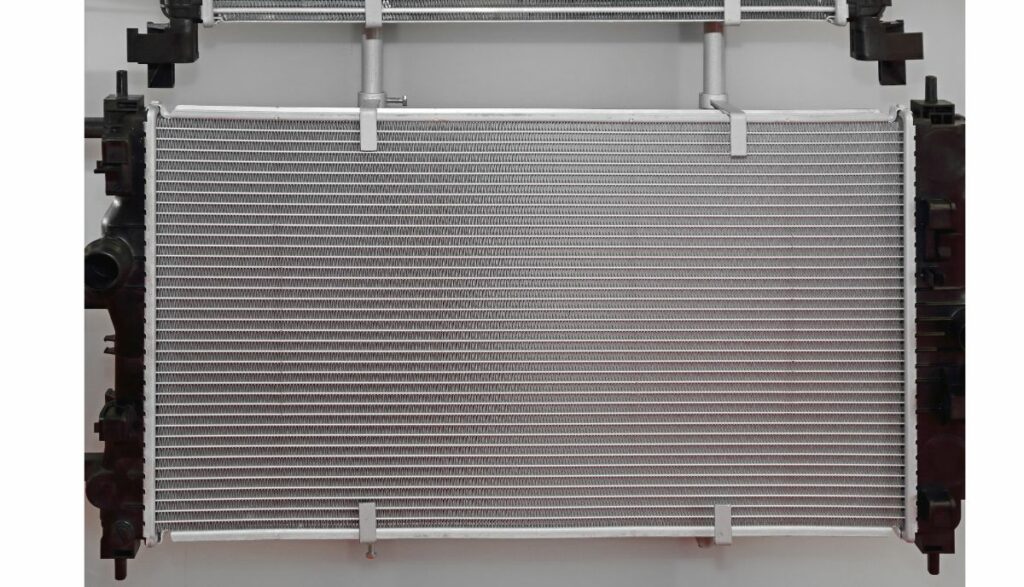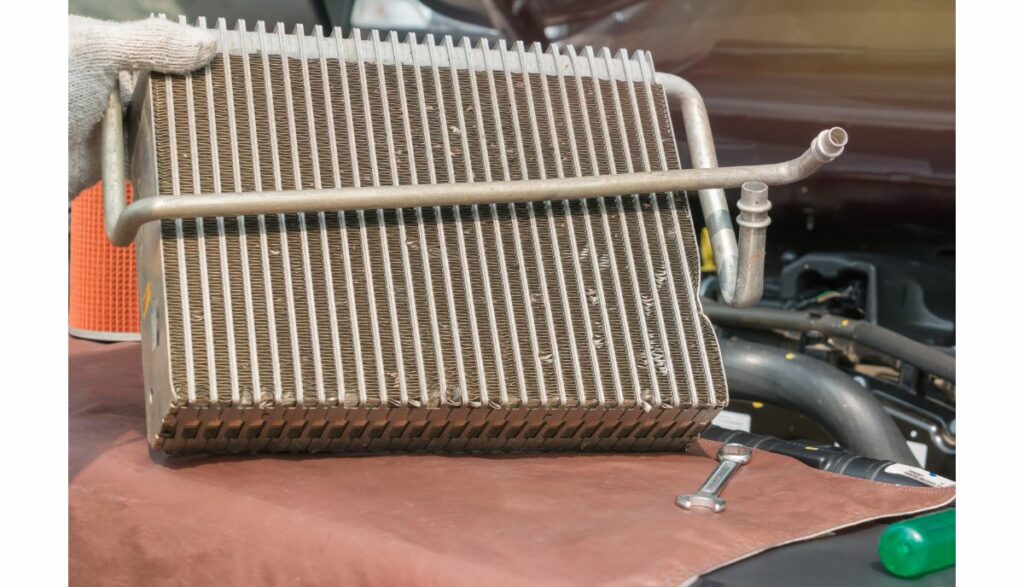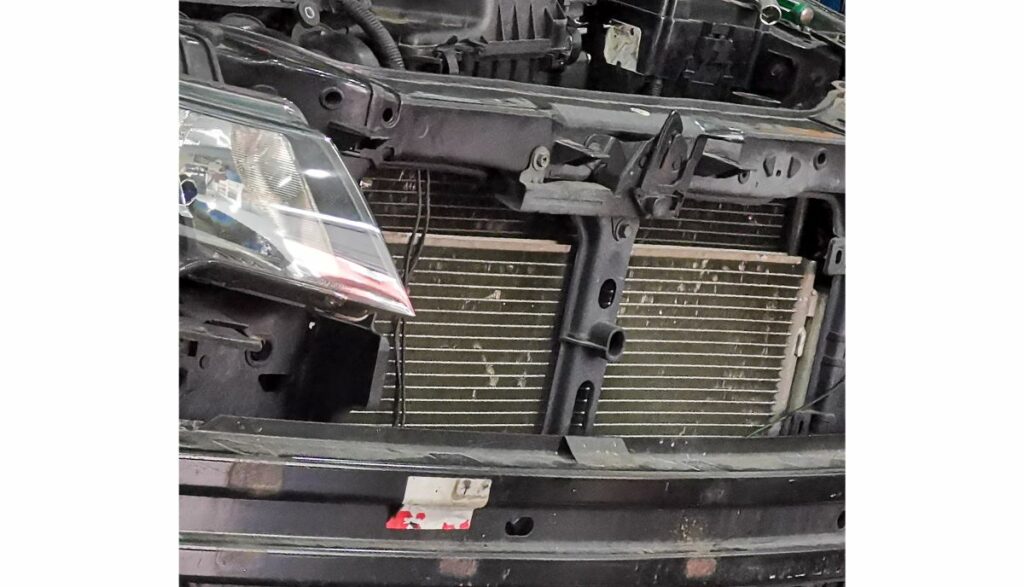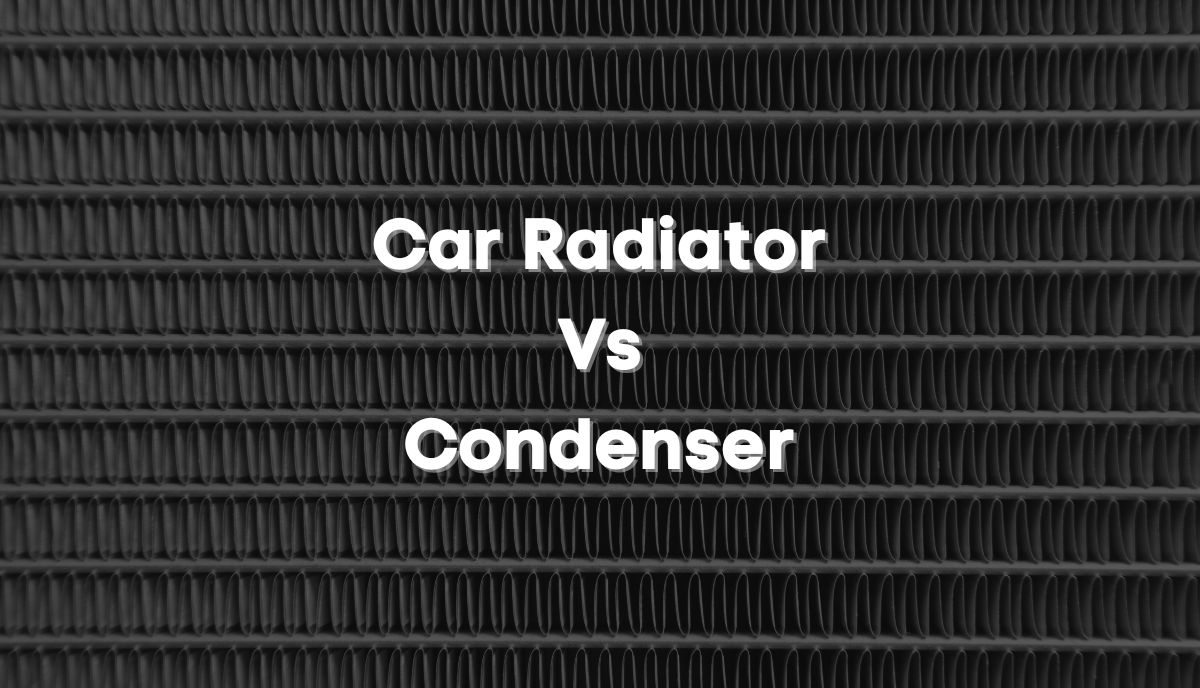P. Mounika and Rajesh K Sharma (Department of Mechanical Engineering, Andhra University College of Engineering), in a paper in the International Journal On Recent Technologies In Mechanical And Electrical Engineering, described the radiator as a device that works with the automotive cooling system to remove heat. But doesn’t that sound like the condenser? What differentiates the radiator from the condenser? The guide below will tell you.
Car Radiator VS Condenser
Car radiators and condensers are similar. Technically speaking, they perform the same function. But the following set them apart from one another:
Function And Purpose
Radiators and condensers operate in different sections of the vehicle. The radiator works with the engine. On the other hand, the condenser is concerned with the air conditioning system.
- Radiator

This paper in the Journal Of Advanced Research In Fluid Mechanics And Thermal Sciences describes the radiator as a heat exchanger that removes the heat from the hot coolant. The coolant becomes hot after flowing through the engine and collecting the heat.
This keeps the engine within an optimal temperature range. Hot coolant will run to the radiator to shed the heat before returning to the engine to collect more heat. Universal Technical Institute has also identified thin metal fins in the radiator that allow the heat to escape to the atmosphere outside the car.
- Condenser

Like the radiator, the condenser is a heat exchanger. It cools heated gas until it condenses into a liquid. The liquid flows through the evaporator and collects heat from the car’s interior cabin.
Location And Configuration
This paper in the International Research Journal of Engineering And Technology expects to find the radiator under the hood but before the engine. You can’t fail to see the radiator if you check the front of the car.

The condenser sits between the grill and the cooling radiator. The radiator and condenser occupy the same area, hence the confusion.
Heat Dissipation And Cooling
Even though both radiators and condensers are heat exchangers that remove heat, they don’t work the same way:
- How does The Radiator dissipate heat From The System By Transferring It To The Surrounding Air?
The coolant absorbs heat as it passes through the engine. It moves to the radiator, which dissipates the heat while allowing air from the atmosphere to flow through the fins and tubes. The air will cool the coolant. This can happen naturally as you drive or via a fan that blows air through the radiator.
If everything goes according to plan, the air around the radiator will heat up as the coolant’s temperature plummets.
- How The Condenser Releases Heat From The Refrigerant To Provide Cool Air In The Cabin?
Like the coolant, the refrigerant will absorb heat from the cabin while in a gaseous state. Then, it condenses to a liquid and releases the heat. Like the radiator, the condenser has fins that assist the cooling process.
Cooling System VS Air Conditioning System
The most significant difference between radiators and condensers is the systems they affect. One deals with the cooling system. The other manages the air conditioning system.
- How The Radiator Is A Crucial Part Of The Vehicle’s Cooling System To Prevent Engine Overheating?
Rinku Jangra, in a paper published by the International Journal Of Engineering Research And Technology, has noted that 30 – 40 percent of the energy from a combustion engine does useful mechanical work. The rest is wasted as heat.
It only takes sixty seconds for a vehicle to sustain notable damage because of excess heat in the engine. The more persistent the excess heat, the more severe the damage.
The cooling system protects the engine by using the coolant to transfer heat from the engine to the radiator, which has the tools to eject it.
- How The Condenser Is An Essential Element Of The Air Conditioning System, Ensuring Cool Air Circulates Inside The Cabin?
The air conditioner lowers the temperature in the cabin by pushing cold air through the vents. But what happens to the heat in the cabin? The refrigerant absorbs it. The condenser changes the refrigerant from gas to liquid as it cools. It uses air flowing through the fins and tubes.
Cooling System Components
While the radiator is vital, it is merely one of several components that allow the cooling system to function.
Components Connected To The Radiator:
- Water Pump – The pump moves the coolant through the radiator, engine block, and cylinder heads.
- Thermostat – The thermostat will either permit or prevent the coolant from flowing, depending on the engine temperature.
- Head Gasket – Prevents the coolant and oil from mixing.
- Radiator Cap – Relieves pressure.
- Hoses – Allow the coolant to move by connecting the different parts of the engine and the cooling system.
- Fan – Pulls air from the atmosphere through the radiator.
- Temperature Gauge – Allows you to keep an eye on the temperature.
- Freeze Plugs – Seal openings in the engine block and cylinder heads.
How They Work Together To Maintain Engine Temperature?
- The same combustion process that produces energy also makes heat.
- The heat is a good thing when you first start the vehicle because you want the engine to warm up.
- Once the engine temperature crosses a threshold, the thermostat opens a valve, allowing the coolant to flow.
- The coolant will pass through the hoses to collect heat from the engine.
- The coolant will take the heat to the radiator.
- The fan will pull air through the radiator to cool the coolant.
- The coolant will return to the water pump.
- The water pump will recirculate the coolant.
- If the coolant gets too hot, the radiator cap will send it to the expansion tank.
Air Conditioning System Components
The Condenser cannot operate independently. It works with other parts to control the temperature in the cabin.
Components Connected To The Condenser:
- Compressor – Turns low-pressure gas into high-pressure gas.
- Dryer – Filters and removes water from the system using desiccants.
- Thermal Expansion Valve – The liquid refrigerant expands, and the pressure reduces.
- Evaporator – Turns refrigerant into a gas.
How They Work Together To Provide Cooled Air In The Cabin?
- Low-pressure gaseous refrigerant will enter the compressor.
- The compressor will send high-pressure gaseous refrigerant to the condenser.
- The condenser will cool and turn the gaseous refrigerant into high-pressure liquid refrigerant.
- The dryer will remove the water.
- The expansion valve will reduce the liquid refrigerant’s pressure.
- The evaporator will turn the refrigerant into a gas.
The transition between liquid and gas allows the refrigerant to remove the heat and humidity in the cabin. This generates the cool, dry air that comes out of the vents.
Maintenance And Troubleshooting
Do radiators and condensers use the same maintenance and troubleshooting methods, or do they differ in that area as well?
Common Radiator Issues
- Leaks
- Rust
- Obstructions
- A defective thermostat that prevents the coolant from flowing.
- Blocked fins.
- Bent fins.
- Raptured radiator hose.
Radiator Maintenance Requirements
- Use the correct coolant for your car.
- Flush the radiator every 30,000 miles.
- Replace leaking hoses.
- Maintain proper coolant levels.
Common Condenser Issues
- Build up of fungi and bacteria that produce a terrible smell.
- Little or no refrigerant.
- The condenser fan is damaged.
- The fins are clogged.
- Leaks.
Condenser Maintenance Requirements
The condenser does not require regular servicing. You only tamper with it when you notice concerning symptoms, such as an AC that doesn’t produce cold air. In that case, you should consider recharging the AC.
Diagnostic Procedures And Repair Considerations For Each Component
How do you diagnose the radiator? Is it the same way you diagnose the condenser? You will notice some mild differences.
Radiator Diagnosis, Troubleshooting, And Repair
- If the engine is overheating, check the coolant levels. Add more coolant if the substance has fallen below the recommended level.
- Do you see puddles of coolant on the ground whenever you park the car? The coolant is leaking. Check the hoses for tears and raptures. Replace damaged hoses.
- Natrad recommends coolant with corrosion inhibitors and demineralized water to prevent corrosion. But if it’s too late, this Evapo-Rust video shows drivers how to use thermocure to remove rust.
- If the coolant changes color, you have sludge buildup in the radiator. Flush the radiator.
- Inspect the radiator’s exterior fins. Use a garden hose to remove dirt and debris.
- If the fins are bent, use pliers to straighten them. But if you’ve observed extensive damage, get a new radiator.
- If the cooling system has become less efficient, add a fan shroud.
- Check the radiator cap for damage or corrosion and replace it where necessary.
- If the check engine light appears after you change the coolant, you probably introduced air pockets. Bleed the radiator.
- Open the hood and start the engine. Make sure the fan turns when high temperatures trigger it. If it refuses to turn, search for loose connections, frayed wiring, and bad motors. You should also consider replacing the fan.
Condenser Diagnostics, Troubleshooting, And Repair
- Rattling and hissing sounds point to a broken condenser.
- Warm air from the vents should encourage you to top up the refrigerant.
- You can find leaks by spraying freon dyes or a water and (heavy) soap solution.
- A technician will respond to low refrigerant levels by unblocking clogged hoses and replacing damaged hoses.
- Unclog the air intake system and replace the cabin filter if the AC keeps cycling on and off.
- The AC will blow hot air if the condenser is blocked. Remove the debris and replace condensers with internal blockages.
- Look for a blown fuse and replace it if the fan refuses to work.
- Replace a damaged fan.
- Tighten loose connections and replace damaged wires.
- After running the AC using the highest cold setting, open the hood and find the condenser. The condenser coil should feel hot at the top, warm in the middle, and cool at the bottom. Replace a condenser that doesn’t work.

